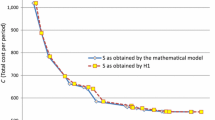Abstract
We develop a multi-objective model in a multi-product inventory system. The proposed model is a joint replenishment problem (JRP) that has two objective functions. The first one is minimization of total ordering and inventory holding costs, which is the same objective function as the classic JRP. To increase the applicability of the proposed model, we suppose that transportation cost is independent of time, is not a part of holding cost, and is calculated based on the maximum of stored inventory, as is the case in many real inventory problems. Thus, the second objective function is minimization of total transportation cost. To solve this problem three efficient algorithms are proposed. First, the RAND algorithm, called the best heuristic algorithm for solving the JRP, is modified to be applicable for the proposed problem. A multi-objective genetic algorithm (MOGA) is developed as the second algorithm to solve the problem. Finally, the model is solved by a new algorithm that is a combination of the RAND algorithm and MOGA. The performances of these algorithms are then compared with those of the previous approaches and with each other, and the findings imply their ability in finding Pareto optimal solutions to 3200 randomly produced problems.
Similar content being viewed by others
References
Chan, C.K., Li, L.Y., Ng, C.T., Cheung, B.K., Langevin, A., 2006. Scheduling of multi-buyer joint replenishments. Int. J. Prod. Econ., 102(1):132–142. [doi:10.1016/j.ijpe.2005.02.005]
Djeffal, F., Bendib, T., 2011. Multi-objective genetic algorithms based approach to optimize the electrical performances of the gate stack double gate (GSDG) MOSFET. Microelectron. J., 42(5):661–666. [doi:10.1016/j.mejo.2011.03.003]
Fonesca, C.M., Fleming, P.J., 1993. Multi Objective Genetic Algorithm. IEE Colloquium on Genetic Algorithms for Control System Engineering, Digest No. 1993/20.
Fung, K.Y., Kwong, C.K., Siu, K.W.M., Yu, K.M., 2012. A multi-objective genetic algorithm approach to rule mining for affective product design. Exp. Syst. Appl., 39(8):7411–7419. [doi:10.1016/j.eswa.2012.01.065]
Gardner, E.S., Dannenbring, D.G., 1979. Using optimal policy surfaces to analyze aggregate inventory trade offs. Manag. Sci., 25(8):709–720. [doi:10.1287/mnsc.25.8.709]
Hsu, S.L., 2009. Optimal joint replenishment decisions for a central factory with multiple satellite factories. Exp. Syst. Appl., 36(2):2494–2502. [doi:10.1016/j.eswa.2008.01.069]
Kang, H., Lee, A., 2010. Inventory replenishment model using fuzzy multiple objective programming: a study of a high-tech company in Taiwan. Appl. Soft Comput., 10(4): 1108–1118. [doi:10.1016/j.asoc.2009.11.035]
Kaspi, M., Rosenblatt, M.J., 1983. An improvement of Silver’s algorithm for the joint replenishment problem. IIE Trans., 15(3):264–269. [doi:10.1080/05695558308974644]
Kaspi, M., Rosenblatt, M.J., 1991. On the economic ordering quantity for jointly replenished items. Int. J. Prod. Res., 29(1):107–114. [doi:10.1080/00207549108930051]
Khouja, M., Michalewicz, M., Satoskar, S., 2000. A comparison between genetic algorithms and the RAND method for solving the joint replenishment problem. Prod. Plan. Control, 11(6):556–564. [doi:10.1080/095372800414115]
Khouja, M., Park, S., Saydam, C., 2005. Joint replenishment problem under continuous unit cost change. Int. J. Prod. Res., 43(2):311–326. [doi:10.1080/0020754042000270368]
Konak, A., Coit, D.W., Smith, A.E., 2006. Multi-objective optimization using genetic algorithms: a tutorial. Rel. Eng. Syst. Safety, 91(9):992–1007. [doi:10.1016/j.ress.2005.11.018]
Li, Q., 2004. Solving the multi-buyer joint replenishment problem with the RAND method. Comput. Ind. Eng., 46(4):755–762. [doi:10.1016/j.cie.2004.05.008]
Moon, K., Cha, B.C., 2006. The joint replenishment problem with resource restriction. Eur. J. Oper. Res., 173(1):190–198. [doi:10.1016/j.ejor.2004.11.020]
Olsen, A., 2008. Inventory replenishment with interdependent ordering: an evolutionary algorithm solution. Int. J. Prod. Econ., 113(1):359–369. [doi:10.1016/j.ijpe.2007.09.004]
Ozkaya, U., Gunes, F., 2012. A modified particle swarm optimization algorithm and its application to the multiobjective FET modeling problem. Turk. J. Electr. Eng. Comput. Sci., 20(2):263–271. [doi:10.3906/elk-1102-1032]
Padmanabhan, G., Vrat, P., 1990. Analysis of multi-item inventory systems under resource constrains: a non-linear goal programming approach. Eng. Costs Prod. Econ., 20(2):121–127. [doi:10.1016/0167-188X(90)90096-Z]
Porras, E., Dekker, R., 2008. A solution method for the joint replenishment problem with correction factor. Int. J. Prod. Econ., 113(2):834–851. [doi:10.1016/j.ijpe.2007.11.008]
Qu, B.Y., Suganthan, P.N., 2010. Multi-objective differential evolution with diversity enhancement. J. Zhejiang Univ.-Sci. C (Comput. & Electron.), 11(7):538–543. [doi:10.1631/jzus.C0910481]
Sahoo, N.C., Ganguly, S., Das, D., 2012. Multi-objective planning of electrical distribution systems incorporating sectionalizing switches and tie-lines using particle swarm optimization. Swarm Evol. Comput., 3:15–32. [doi:10.1016/j.swevo.2011.11.002]
Siajadi, H., Ibrahim, R.N., Lochert, P.B., Chan, W.M., 2005. Joint replenishment policy in inventory production systems. Prod. Plan. Control, 16(3):255–262. [doi:10.1080/09537280500033213]
Singh, D.P., Khare, A., 2011. Different aspects of evolutionary algorithms, multi-objective optimization algorithms and application domain. Int. J. Adv. Network. Appl., 2(4):770–775.
Sundar, D., Umadevi, B., Alagarsamy, K., 2010. Multi-objective genetic algorithm for the optimized resource usage and the prioritization of the constraints in the software project planning. Int. J. Comput. Appl., 3(3):1–4. [doi:10.5120/718-1010]
Tsou, C., 2009. Evolutionary Pareto optimized for continuous review stochastic inventory system. Eur. J. Oper. Res., 195(2):364–371. [doi:10.1016/j.ejor.2008.02.039]
Wang, L., He, J., Wu, D., Zeng, Y.R., 2012. A novel differential evolution algorithm for joint replenishment problem under interdependence and its application. Int. J. Prod. Econ., 135(1):190–198. [doi:10.1016/j.ijpe.2011.06.015]
Wang, Y.C., Cheng, W.T., 2008. A sensitivity analysis of solving joint replenishment problems using the RAND method under inaccurate holding cost estimates and demand forecasts. Comput. Ind. Eng., 55(1):243–252. [doi:10.1016/j.cie.2007.12.010]
Wee, H.M., Lo, C.C., Hsu, P.H., 2009. A multi-objective joint replenishment inventory model of deteriorated items in a fuzzy environment. Eur. J. Oper. Res., 197(2):620–631. [doi:10.1016/j.ejor.2006.08.067]
Xu, J., Liu, Y., 2008. Multi-objective decision making model under fuzzy random environment and its application to inventory problems. Inf. Sci., 178(14):2899–2914. [doi:10.1016/j.ins.2008.03.003]
Xu, J., Zhao, L., 2010. A multi-objective decision-making model under fuzzy rough coefficient and its application to inventory problem. Inf. Sci., 180(5):679–696. [doi:10.1016/j.ins.2009.11.002]
Author information
Authors and Affiliations
Corresponding author
Rights and permissions
About this article
Cite this article
Yousefi, O., Aryanezhad, M., Sadjadi, S.J. et al. Developing a multi-objective, multi-item inventory model and three algorithms for its solution. J. Zhejiang Univ. - Sci. C 13, 601–612 (2012). https://doi.org/10.1631/jzus.C1100384
Received:
Accepted:
Published:
Issue Date:
DOI: https://doi.org/10.1631/jzus.C1100384




